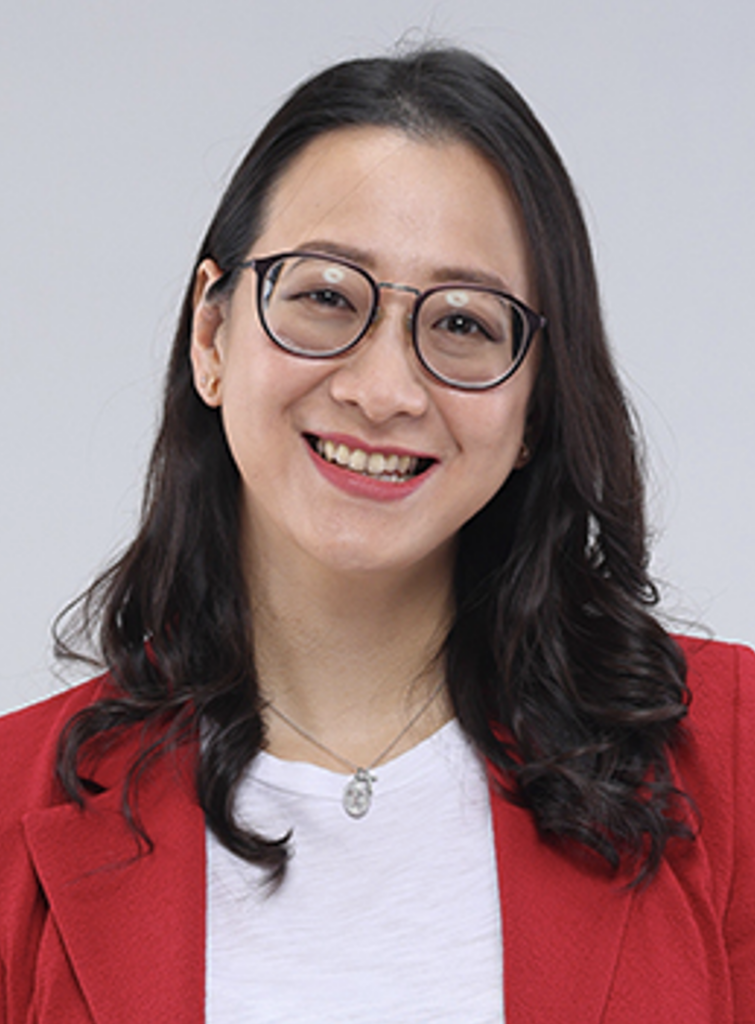Case Study of Good T&L Practices > List of Case Studies > Professor Rhea Patricia LIEM
Biography

Professor Rhea Patricia LIEM
Assistant Professor
Department of Mechanical and Aerospace Engineering
The Hong Kong University of Science and Technology
Awardee of 2021
(Category: Early Career Faculty Members)
Professor Rhea Patricia LIEM joined Hong Kong University of Science and Technology (HKUST) in 2015 as an Assistant Professor in the Department of Mechanical and Aerospace Engineering. She holds degrees from Nanyang Technological University (NTU), Massachusetts Institute of Technology (MIT), and University of Toronto Institute for Aerospace Studies (UTIAS). She is a Vanier Canada Graduate Scholar and was the 2012 recipient of the Zonta International Amelia Earhart Fellowship Award. Professor Liem has made a significant contribution to and impact on her department during her tenure at the University. During her academic career at HKUST, she was twice awarded the School of Engineering Teaching Excellence Appreciation Award (2018 and 2021).
Professor Liem is passionate about engaging with learners, including her students and those she comes into contact with through other organisations, such as the Hong Kong Aerospace Leaders Association. She has a genuine and infectious passion for her subject area and an empathy and understanding for her students, which shape her highly effective and motivational pedagogical approach.
Teaching Philosophy
Part I: Teaching Philosophy
Professor Liem’s teaching philosophy stresses the importance of having the right attitude towards learning at university: “A university is a platform for students’ self-discovery with teachers as facilitators,” she says.
Her excellence in teaching results from her dedicated care and focus on creating the best learning experience for her students. Her teaching is founded on three key aspects.
1. Helping Students Realize the Values of Learning
Professor Liem has noticed that students often see studying as a burden or stressor, so her deep appreciation for learning and education motivates her to work to instil a positive and purpose-driven attitude towards learning in her students. Professor Liem often shares her perspectives and personal experiences with her students to help them see the value of learning.
Professor Liem uses a guided self-learning assignment in her courses. For this assignment, students perform a small piece of research on a topic they choose (with instructor approval), perform a literature review on the topic, and synthesise what they learn in a short essay or term paper. Students have expressed appreciation for the opportunity to engage in self-study on a topic they are genuinely interested in and have found this learning process to be enjoyable and more effective than more traditional assignments. Professor Liem sees this assignment as a way to nurture budding talent and interest in teaching and researching in her students.
2. University Education Must be Student-Centric
Professor Liem has developed a set of effective guiding principles to ensure that she puts her students first in her teaching and course designs.
a) Be aware of students’ difficulties in absorbing course materials
Professor Liem understands that her teaching materials should not be so complex that students cannot understand them, but not so simple that students do not feel challenged and engaged. She encourages students to tell her directly when they feel the pace is too fast or slow or when they have difficulty understanding concepts or following her explanations. She is always willing to make adjustments when needed.
She presents easier concepts or more interesting topics (e.g., aircraft design case studies) during mid-term exam periods to provide a needed distraction and a break in difficult material for students. She has found that this practice helps relieve students’ stress while maximising their learning outcomes.
b) Treat students with mutual trust and respect – small things matter
Professor Liem addresses all her students by their names. She has found that such small gestures “humanise” the student–teacher relationship and make students feel appreciated and acknowledged. She has found that putting effort into her relationships with her students makes students more responsive to her teaching and mentoring.
c) Pay attention to the well-being of students and empathise with them
Professor Liem believes that a successful student is, first and foremost, a happy student. She has also noticed that being a woman and a foreigner makes her more approachable. She tries to be a friend to her students and actively reaches out to her students if she notices any worrying signs.
d) Engage students as allies
In Professor Liem’s classes, everybody has a chance to contribute. For example, students are encouraged to suggest topics to be covered in class, to help to answer other students’ questions, and to provide other sources of information. Professor Liem sometimes involves students in decisions on lecture schedules, assignments, and course assessments.
During the switch to online or mixed-mode teaching, Professor Liem invited students to give ideas on improving their learning experiences.
3. The Most Important Question:” “How Can I Teach My Student to Think Critically?”
Professor Liem realises that in the fast-changing landscape of science and technology research, we need to strike a balance between introducing current, state-of-the-art technologies (which may soon be replaced by newer technologies) and strengthening students’ understanding of the scientific principles behind these technological breakthroughs.
In her teaching, Professor Liem teaches students how to think and learn independently and to critically assess technological advancements and contribute to them. She uses the following guiding principles:
a) Strengthen students’ understanding of basic science and mathematics
Professor Liem shows how to derive equations used in class when appropriate. Students are shown how complex aerospace engineering phenomena can be explained by basic physics and modelled through basic mathematics. By understanding how an equation is derived and what assumptions are made, students can apply the equation to solve both simple and complex problems without memorising the formula.
b) Use real-world examples to explain engineering concepts
Professor Liem challenges students to explain recent advancements in aircraft systems based on what they learn in class. This exercise excites and motivates students to apply their knowledge and develop a deeper understanding of the topic.
c) Focus on assessing students’ thinking processes rather than the correctness of their answers
Professor Liem asks her students to explain their rationale when answering homework or exam questions, which are scenario-based questions, instead of just writing down the equations and answers.
d) Spark their interest, then guide their thinking processes
Teaching complex engineering concepts can be challenging. Professor Liem likes to give a “sneak preview” of an answer followed by a series of “why” questions until students develop the answers themselves (that “ah ha!” moment).
For example, Professor Liem may show this F-117 picture to pique students’ curiosity before she asks, “Why is the shape very different from the typical tube-and-wing configuration?” and “How do we make this diamond-shaped craft fly?” This approach has led to fruitful discussions, and, when Professor Liem subsequently presents theories of aircraft design, the students are much more engaged.

4. Teaching Is More a Vocation than a Job
Professor Liem views her role as a teacher as extending far beyond the classroom— “Sometimes I feel like an ‘academic parent’ to students,” she says. She encourages students to find something that they truly love and are passionate about and to pursue it, and she wants students to enjoy learning instead of focusing only on good grades. Many students look up to Professor Liem as a role model, an educator, and a woman in engineering.
A video by the UGC showcasing Professor Liem’s teaching philosophy can be accessed here.
︽Back to topAchievement/Good Practices
Part II: Achievements/Good Practices
Implement Teaching and Learning Innovations
In the Aircraft Design course, students must complete a design project that utilises different disciplines (e.g., aerodynamics, structures, propulsion) in the design process and then iteratively analyse the interdisciplinary coupling. Students must also understand the numerical and computing tools required to complete the task. This may quickly become overwhelming for teachers and students. Professor Liem received a Teaching Development Grant (TDG) in early 2020 to develop a computational platform suitable for this design project. The programming language (Julia) and user interface (Pluto notebook) were carefully selected to maximise usability. The platform was piloted in the Aircraft Design course during the Spring 2020/21 term. A usability test was conducted in January 2021, and the feedback showed that the following objectives were achieved.
- The platform helped students to become familiar and comfortable with basic programming and to understand the rationales and computational details behind the algorithms;
- The platform allowed students to focus on the important steps of the aircraft design process due to its clarity and ease of use;
- The platform demonstrated the importance of programming and computational methods in modern-day engineering, which increased students’ appreciation of these tools.
Professor Liem continuously receives positive feedback from Aircraft Design students on the platform. Moreover, she has since been granted a second TDG to extend the platform’s usage to other courses to enable a more holistic approach. The platform can also be used to introduce computational paradigms that are necessary in any engineering industry (e.g., optimisation, sensitivity analysis) by demonstrating their usages in the context of aerospace engineering applications. Additionally, the platform can incorporate artificial intelligence and machine learning components into the aerospace curriculum at HKUST, which can be incorporated into new or existing courses. It is Professor Liem’s goal to improve both her course and other courses in the department and to align her efforts with the vision and strategic direction of the University.
Supporting Undergraduate Research Disciplines
Professor Liem believes in nurturing research skills from the undergraduate level. The undergraduate research opportunity programme (UROP) student she supervised won the Mr. Armin and Mrs. Lillian Kitchell Undergraduate Research Award in 2020.
Undergraduate Administrative Role in Mechanical and Aerospace Engineering
Professor Liem has been the Undergraduate Liaison Officer for her department since 2020. While many activities have been limited due to the pandemic, she regularly communicates with students and discusses diverse topics such as dealing with changing plans, scientific writing, and even mental health. Through this role, she has been exposed to the non-academic aspects of teaching. She has learned from University counsellors about how to strengthen students’ well-being, which has helped her connect with students inside and outside the classroom.
Through student–faculty meetings, Professor Liem is aware of students’ concerns and challenges in their studies. Addressing some of these challenges is an ongoing objective of her teaching innovation programme, which has received positive feedback.
Improving Aircraft Design Education
In her field, Professor Liem has participated in aircraft design education workshops and presented “Modern Aircraft Design Goes Beyond the Classical Aerospace Engineering” at the Asian Workshop on Aircraft Design Education (AWADE 2016) in Nanjing University of Aeronautics and Astronautics (Oct 2016). She has proactively learned from more experienced aircraft design course instructors, and, with support from a Teaching Development Grant, she is developing an educational aircraft design platform and is planning to publish the work in an international journal.
